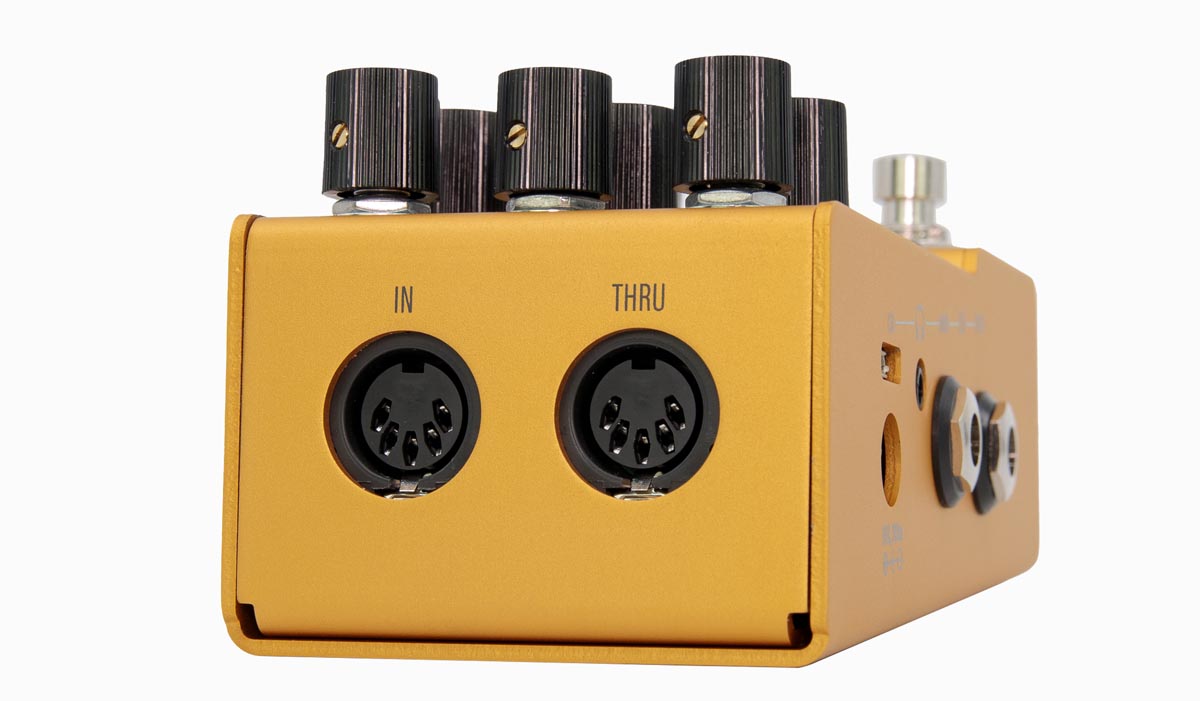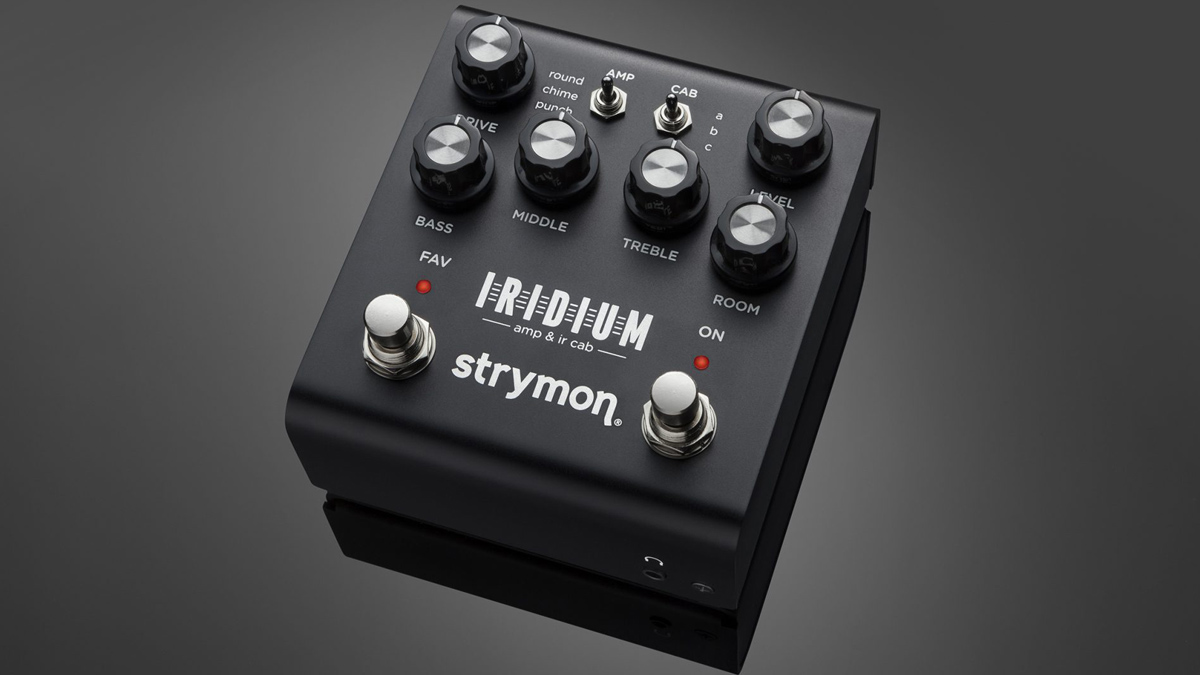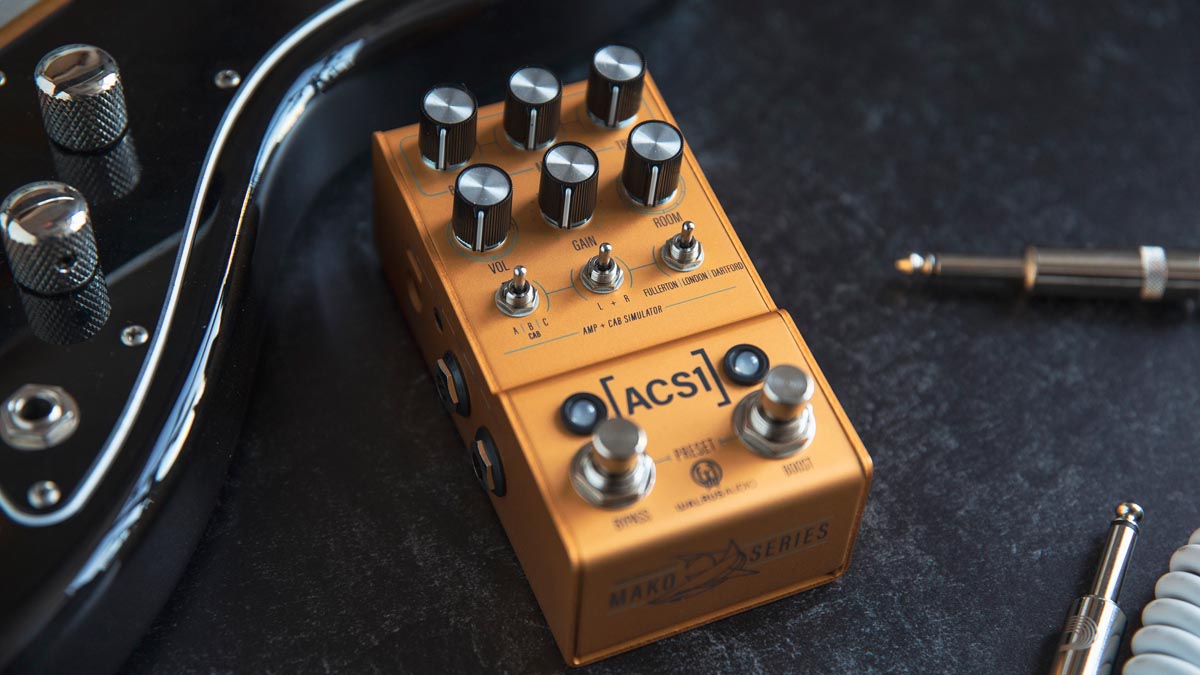MusicRadar Verdict
The ACS1 lets you expand your amp sounds the easy way, with a form and design that fits neatly into your rig. It's super-practical for the gigging musician, but will also find its uses in the studio.
Pros
- +
Convincing amp tones.
- +
Small size.
- +
MIDI controllable.
- +
Headphones output.
Cons
- -
Lacks a little gain.
- -
No manual mode.
MusicRadar's got your back
Walrus Audio Mako Series ACS1 Amp + Cab Simulator: What is it?
Walrus Audio's Mako Series ACS1 Amp + Cab Simulator promises three distinct models of vintage guitar amps, with onboard speaker emulations sharing space with a remarkable array of practical features from a pedal that's about the size of a regular Boss stompbox.
As with pedals such as the MusicRadar approved Strymon Iridium, it puts some heavy digital processing power to good use in offering the chance to switch between vintage Fender, Marshall and Vox tube amps on the fly. No valves will need changing. No lugging things up the stairs.
Of course, you'll need a power amp or a regular amplifier to send it through a speaker, but the ACS1 can fit nicely on your pedalboard and dramatically expand the sounds available to you.
The Fullerton mode is based on a Fender Deluxe Reverb, London replicates a 1962 Marshall Bluesbreaker, while Dartford mimics the chime and sparkle of a 1960s vintage Vox AC30.


The ACS1 shares the same six-knob designs as other Mako Series pedals such as the Mako D1 High-Fidelity Stereo Delay and shares a similar array of inputs and outputs, with MIDI connections available at the top of the unit, and stereo inputs and outputs giving you the choice of running it in mono or stereo. There's also a headphones output for silent practice.
Out of the box, the ACS1 has six custom cabinet impulse responses, but you can upload your own via USB using the bundled software.
This being a three-amps-in-a-box pedal, and as such a radically 21st-century concept, it is reassuring to find that the controls are like those we'd find on our amplifiers. There are knobs for Volume, Gain, Bass, Middle and Treble, plus a Room control that allows you to dial in a little ambience and digitally transform the size of the space you are playing in.
Want all the hottest music and gear news, reviews, deals, features and more, direct to your inbox? Sign up here.
Like the other Mako Series pedals, the ACS1 has a trio of toggle switches arranged underneath the knobs. There are two for selecting your amp model and speaker pairing, and a third L + R switch for selecting which channel you want the controls to affect, and indeed which amp type you want to run it.
There are two footswitches. One for bypassing/engaging the pedal, the other for applying a boost, which applies a user-defined amount of gain and volume for an extra little kick. Simply press the boost switch, its LED will flash, adjust your volume and gain accordingly and when you next step on the boost it will remember your setting for that preset.
Walrus Audio Mako Series ACS1 Amp + Cab Simulator: Performance and verdict
The ACS1 pairs its three amp models with a pair of cabinet emulations. There are three "front cabs" which are selected via the three-way toggle switch and three "back cabs" which are selected by holding down bypass and adjusting the toggle switch.
The Fullerton's front cabinet is a classic Fender Deluxe, with a deeper-sounding Super Reverb on the back cabinet. The London mode offers a Two Rock Creamback cab and a Marshall 4x12, while the Dartford has a Vox Blueback and Greenback cabinets as standard.
There are three presets available on the unit, which are accessed via the two footswitches, and 128 in total when you bring MIDI into the equation. This is where the ACS1 is less amp-like and more Mako Series-like, in operating on a presets basis as opposed to adjusting the dials manually.

• Strymon Iridium
Awesome cab sims allied to great tones from three amp classics make the Iridium a hugely versatile and compact all-in-one rig for the stage or the studio.
• Origin Effects RevivalDrive Custom
With an ability to mimic a whole range of amps, notably Marshall and Fender models, or provide overdrive that’s perfectly tailored to be an extension of your clean amp tone, it will give you a proper cranked vintage amp sound at practical stage and home levels whatever amp you are using.
• Line 6 HX Stomp
It's not as flexible on-the-fly as its larger forebears, but the HX Stomp offers a staggering number of tones from a pedalboard-friendly package.
That might take a little getting used to for some people but the ease of use cannot be quibbled with. Press down both footswitches to scroll through the three onboard presets and the LED will light red, green, and blue to let you know which you are on. To edit, call up the preset, adjust the knobs, and then hold down both Bypass and Boost switches until the LEDs stop blinking.
Should you choose to run the ACS1 in stereo, you have options. You can send your amp of choice through both left and right channels, or alternatively – and this is very cool – you can mix and match, sending, say, the Marshall-esque London grind down the left channel while having the Fullerton's Fender-esque spank going on in the right channel.
The sounds are impeccable. Indeed, they respond very much like the tube amplifiers they are modelled after. The Fullerton has that Big F headroom and the sort of response that makes a neck single-coil pickup bounce out of the speaker, while the Dartford is an addictive and authentically Vox.
There's no mistaking where the London mode is taking its inspiration from either, though, as with the Dartford mode, a little more gain would have been welcome, making the ACS1 even more useful. That said, with its size, it's destined to be nested within a pedalboard and throwing an overdrive pedal in front of it will tease out some extra sparkle from the Vox model and get that Bluesbreaker to show its teeth.
MusicRadar verdict: The ACS1 lets you expand your amp sounds the easy way, with a form and design that fits neatly into your rig. It's super-practical for the gigging musician, but will also find its uses in the studio.
Walrus Audio Mako Series ACS1 Amp + Cab Simulator: The web says
"The amps and cabs deliver an authentic playing experience over a range from clean through dirtier sounds, although we feel that if Walrus offered a little more gain for each beyond the presumably authentically recreated limits, it would add to the versatility."
Guitarist
"Sparking up the pedal in mono mode, the first preset – based on a Fender Deluxe Reverb – twinkles from our monitors with instant prettiness. It sounds bang-on, with an openness to the mids and a roundness to the bass that makes Strymon’s effort sound ever so slightly flat in comparison."
Guitar
"If you’re planning on ditching your amp, and travelling lighter to your next gig (whenever that may be), or you simply want more options, the ACS1 will do the job. If you want high-gain though, it’s probably better to bring along the rest of your pedals. Which, if you’re sticking this on your pedalboard, probably won’t be an issue."
Gearnews
Walrus Audio Mako Series ACS1 Amp + Cab Simulator: Hands-on demos
Walrus Audio
Reverb
Guitar Bonedo
Rabea Massaad
Walrus Audio Mako Series ACS1 Amp + Cab Simulator: Specifications
- ORIGIN: USA
- TYPE: Amp and cab simulator pedal
- FEATURES: True bypass, 3 onboard presets, MIDI, 3 amp types, 6 factory IRs, IR loading
- CONTROLS: Bass, Mid, Treble, Volume, Gain, Room, Cab switch (A/B/C), L+R switch, Amp switch (Fullerton/London/Dartford), Boost footswitch, Bypass footswitch
- AMP & CABS: Fullerton (Fender), London (Marshall), Dartford (Vox);
- CABS: Fender Deluxe, Marshall 4x12, Vox Green Back, Fender Super Reverb, Two Rock, Vox Blue Back
- CONNECTIONS: Standard inputs (Left/Mono, Right), standard outputs (Left/Mono, Right), mini-jack headphone output, USB, MIDI in, MIDI out
- POWER: 9V DC adaptor (not supplied) 300mA
- DIMENSIONS: 73 (w) x 125 (d) x 60mm (h)
- CONTACT: Walrus Audio
MusicRadar is the number one website for music-makers of all kinds, be they guitarists, drummers, keyboard players, DJs or producers...
- GEAR: We help musicians find the best gear with top-ranking gear round-ups and high-quality, authoritative reviews by a wide team of highly experienced experts.
- TIPS: We also provide tuition, from bite-sized tips to advanced work-outs and guidance from recognised musicians and stars.
- STARS: We talk to musicians and stars about their creative processes, and the nuts and bolts of their gear and technique. We give fans an insight into the craft of music-making that no other music website can.

